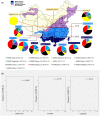Epidemiology, evolutionary origin, and malaria-induced positive selection effects of G6PD-deficient alleles in Chinese populations
- PMID: 33128437
- PMCID: PMC7767544
- DOI: 10.1002/mgg3.1540
Epidemiology, evolutionary origin, and malaria-induced positive selection effects of G6PD-deficient alleles in Chinese populations
Abstract
Background: Although glucose-6-phosphate dehydrogenase (G6PD) deficiency is the most common inherited disorder in the Chinese population, there is scarce evidence regarding the epidemiology, evolutionary origin, and malaria-induced positive selection effects of G6PD-deficient alleles in various Chinese ethnic populations.
Methods: We performed a large population-based screening (n = 15,690) to examine the impact of selection on human nucleotide diversity and to infer the evolutionary history of the most common deficiency alleles in Chinese populations.
Results: The frequencies of G6PD deficiency ranged from 0% to 11.6% in 12 Chinese ethnic populations. A frequency map based on geographic information showed that G6PD deficiency was highly correlated with historical malaria prevalence in China and was affected by altitude and latitude. The five most frequently occurring G6PD gene variants were NM_001042351.3:c.1376G>T, NM_001042351.3:c.1388G>A, NM_001042351.3:c.95A>G, NM_001042351.3:c.1311T>C, and NM_001042351.3:c.1024C>T, which were distributed with ethnic features. A pathogenic but rarely reported variant site (NM_001042351.3:c.448G>A) was identified in this study. Bioinformatic analysis revealed a strong and recent positive selection targeting the NM_001042351.3:c.1376G>T allele that originated in the past 3125 to 3750 years and another selection targeting the NM_001042351.3:c.1388G>A allele that originated in the past 5000 to 6000 years. Additionally, both alleles originated from a single ancestor.
Conclusion: These results indicate that malaria has had a major impact on the Chinese genome since the introduction of rice agriculture.
Keywords: Chinese population; evolutionary origin; glucose-6-phosphate dehydrogenase (G6PD); malaria; natural selection.
© 2020 The Authors. Molecular Genetics & Genomic Medicine published by Wiley Periodicals LLC.
Conflict of interest statement
The authors report no conflicts of interest.
Figures




References
-
- Beutler, E. , Duparc, S. , & Group, G. P. D. W. (2007). Glucose‐6‐phosphate dehydrogenase deficiency and antimalarial drug development. American Journal of Tropical Medicine and Hygiene, 77(4), 779–789. - PubMed
-
- Buetow, K. H. , Edmonson, M. , MacDonald, R. , Clifford, R. , Yip, P. , Kelley, J. , & Braun, A. (2001). High‐throughput development and characterization of a genomewide collection of gene‐based single nucleotide polymorphism markers by chip‐based matrix‐assisted laser desorption/ionization time‐of‐flight mass spectrometry. Proceedings of the National Academy of Sciences of the United States of America, 98(2), 581–584. 10.1073/pnas.021506298 - DOI - PMC - PubMed
Publication types
MeSH terms
Substances
Grants and funding
- 2019JJD140052/Guangxi Key Research and Development Foundation/International
- AB18221029/Guangxi Key Research and Development Foundation/International
- 2019-GDXK-0031/Key Scientific Research Projects of Guangdong Provincial Department of Education/International
- CZK20200602/Special Technology Program of Chaozhou for Novel Coronavirus Infection Control/International
- CZK20200603/Special Technology Program of Chaozhou for Novel Coronavirus Infection Control/International
LinkOut - more resources
Full Text Sources
Medical
Miscellaneous

